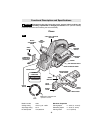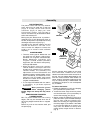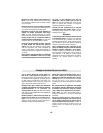
-3-
Do not force tool. Use the correct tool for
your application. The correct tool will do the
job better and safer at the rate for which it is
designed.
Do not use tool if switch does not turn it
“ON” or “OFF”. Any tool that cannot be
controlled with the switch is dangerous and
must be repaired.
Disconnect the plug from the power source
before making any adjustments, changing
accessories, or storing the tool. Such
preventive safety measures reduce the risk of
starting the tool accidentally.
Store idle tools out of reach of children and
other untrained persons. Tools are
dangerous in the hands of untrained users.
Maintain tools with care. Keep cutting tools
sharp and clean. Properly maintained tools,
with sharp cutting edges are less likely to bind
and are easier to control. Any alteration or
modification is a misuse and may result in a
dangerous condition.
Check for misalignment or binding of
moving parts, breakage of parts, and any
other condition that may affect the tools
operation. If damaged, have the tool
serviced before using. Many accidents are
caused by poorly maintained tools. Develop a
periodic maintenance schedule for your tool.
Use only accessories that are
recommended by the manufacturer for
your model. Accessories that may be suitable
for one tool, may become hazardous when
used on another tool.
Service
Tool service must be performed only by
qualified repair personnel. Service or
maintenance performed by unqualified
personnel could result in a risk of injury. For
example: internal wires may be misplaced or
pinched, safety guard return springs may be
improperly mounted.
When servicing a tool, use only identical
replacement parts. Follow instructions in
the Maintenance section of this manual.
Use of unauthorized parts or failure to follow
Maintenance Instructions may create a risk of
electric shock or injury. Certain cleaning
agents such as gasoline, carbon tetrachloride,
ammonia, etc. may damage plastic parts.
Safety Rules for Planers
Secure the material being planed. Never
hold it in your hand or across legs. Small
workpiece must be adequately secured so
that the rotating planer blades will not pick it
up during forward motion of the planer.
Unstable support can cause the blades to
bind causing loss of control and injury.
Make sure the spring operated automatic
retracting rabbet guard returns to blade
covering position instantly. The blades are
hidden from view and you may be cut if
blade is contacted.
Always start the plane before blade is in
contact with the workpiece and allow the
blade to come to full speed. Tool can
vibrate or chatter if blade speed is too slow
at beginning of cut and possibly kickback.
Check the workpiece for nails, if there are
nails, either remove or set them well
below intended finished surface. If the
planer blades strike objects like nails it may
cause the tool to kickback and serious
personal injury may result.
Never leave the trigger locked “ON”.
Unplug the planer before changing
accessories. Before plugging the tool in,
check that the trigger lock is "OFF".
Accidental start-ups may occur if planer is
plugged in while changing an accessory.
After changing blades, rotate the blade
drum to make sure blades are not hitting
any part of the blade head housing and
the blade locking screws are tight.
Spinning blades could strike tool housing
and damage tool as well as possible injury.


















